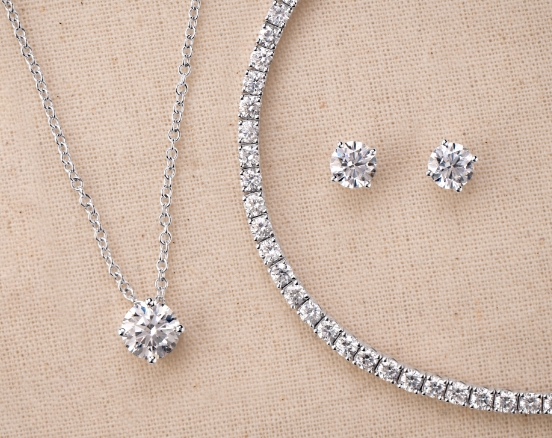
Diamonds and sapphires have captivated the human imagination for centuries, each possessing its unique allure and charm. In this article, we delve into the intricate world of these two precious gemstones, examining their composition, characteristics, symbolism, and more to help you navigate the age-old debate of diamonds vs sapphires.
Table of Contents
Composition and Formation
Diamonds: Diamonds, renowned for their hardness and brilliance, are composed of carbon atoms arranged in a crystal lattice structure. They form deep within the Earth’s mantle under extreme heat and pressure over millions of years, emerging to the surface through volcanic eruptions.
Sapphires: Sapphires, belonging to the corundum mineral family, consist mainly of aluminum oxide with trace elements such as iron, titanium, and chromium. Their formation occurs in diverse geological environments, including igneous rocks and alluvial deposits.
Physical Characteristics
Hardness and Durability: Diamonds reign supreme in the realm of hardness, scoring a perfect 10 on the Mohs scale, making them the hardest natural substance known to man. Sapphires, although durable with a rating of 9, fall slightly short in comparison.
Brilliance and Luster: Diamonds exhibit unparalleled brilliance and sparkle due to their exceptional refractive index and dispersion of light. Sapphires possess a unique velvety luster, captivating admirers with their depth of color and clarity.
Color Varieties
Diamonds: While traditionally associated with white or colorless stones, diamonds come in a spectrum of hues, including yellow, pink, blue, green, and even black. Fancy colored diamonds, such as blue and pink diamonds, command premium prices due to their rarity.
Sapphires: Sapphires are renowned for their vivid blue color, but they also occur in various shades such as pink, yellow, green, purple, and orange. The most coveted sapphires exhibit a rich, royal blue hue known as “cornflower blue.”
Clarity and Transparency
Diamonds: Clarity refers to the absence of internal flaws or inclusions in diamonds, with flawless stones being exceedingly rare and valuable. The presence of inclusions can affect a diamond’s transparency and overall beauty.
Sapphires: Sapphires may contain inclusions known as “silk,” which are tiny needle-like crystals that can enhance the stone’s appearance by creating a desirable shimmer effect known as asterism.
Cost and Value
Factors Influencing Diamond Prices: Diamond prices are influenced by the famous 4Cs: cut, color, clarity, and carat weight. Additionally, factors such as diamond shape, fluorescence, and certification can impact their value.
Price Considerations for Sapphires: Diamonds vs Sapphires: Exploring the Eternal Debate by factors such as color intensity, clarity, cut quality, and size. Exceptionally large or vividly colored sapphires can command high prices at auctions and gem shows.
Symbolism and Significance
Cultural and Historical Significance of Diamonds: Diamonds have long been associated with wealth, status, and eternal love. From ancient civilizations to modern-day royalty, diamonds have adorned monarchs, symbolizing power, purity, and endurance.
Symbolism Attached to Sapphires: Sapphires hold diverse cultural meanings, representing wisdom, virtue, and divine favor in various cultures. In ancient times, sapphires were believed to protect wearers from harm and attract blessings.
Popular Uses
Jewelry Industry Applications: Both diamonds and sapphires are prized for their beauty and durability, making them ideal choices for engagement rings, wedding bands, earrings, necklaces, and bracelets.
Industrial Uses: Beyond adornment, diamonds find applications in industries such as cutting, drilling, grinding, and abrasion due to their exceptional hardness. Sapphires are used in precision instruments, watchmaking, and electronics for their durability and scratch-resistant properties.
Ethical Considerations
Ethical Mining and Sourcing Practices: The diamond industry has made strides in promoting ethical mining practices and ensuring responsible sourcing through initiatives like the Kimberley Process. Consumers can choose certified conflict-free diamonds to support ethical practices.
Conflict-Free Alternatives: For those concerned about ethical issues, lab-grown diamonds offer a sustainable and ethical alternative to lab diamonds, with the same physical and chemical properties.
Maintenance and Care
Tips for Caring for Diamond Jewelry: To maintain the brilliance of diamond jewelry, regular cleaning with a mild detergent and soft brush is recommended. Avoid exposing diamonds to harsh chemicals or abrasive materials that can damage their surfaces.
Maintenance Guidelines for Sapphire Gemstones: Sapphires require gentle care to preserve their luster and beauty. Clean sapphire jewelry with a soft cloth and mild soapy water, avoiding ultrasonic cleaners that can damage the stone.
Personal Preferences and Style
Factors Influencing Individual Preferences: Personal taste, budget, lifestyle, and cultural influences play significant roles in determining whether one favors diamonds or sapphires for jewelry.
Matching Gemstones with Personal Style: Diamonds exude timeless elegance and sophistication, while sapphires add a touch of color and individuality to jewelry pieces, allowing wearers to express their unique style.

